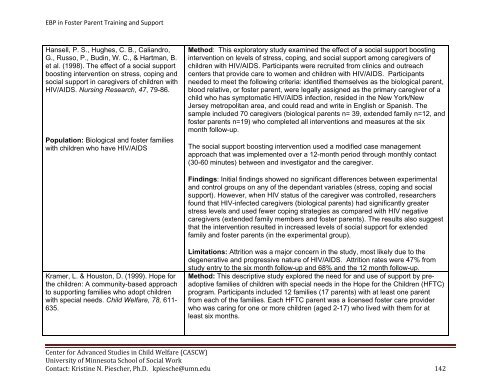Evidence-Based Practice in Foster Parent Training and Support ...
Evidence-Based Practice in Foster Parent Training and Support ...
Evidence-Based Practice in Foster Parent Training and Support ...
You also want an ePaper? Increase the reach of your titles
YUMPU automatically turns print PDFs into web optimized ePapers that Google loves.
EBP <strong>in</strong> <strong>Foster</strong> <strong>Parent</strong> Tra<strong>in</strong><strong>in</strong>g <strong>and</strong> <strong>Support</strong>Hansell, P. S., Hughes, C. B., Cali<strong>and</strong>ro,G., Russo, P., Bud<strong>in</strong>, W. C., & Hartman, B.et al. (1998). The effect of a social supportboost<strong>in</strong>g <strong>in</strong>tervention on stress, cop<strong>in</strong>g <strong>and</strong>social support <strong>in</strong> caregivers of children withHIV/AIDS. Nurs<strong>in</strong>g Research, 47, 79-86.Population: Biological <strong>and</strong> foster familieswith children who have HIV/AIDSMethod: This exploratory study exam<strong>in</strong>ed the effect of a social support boost<strong>in</strong>g<strong>in</strong>tervention on levels of stress, cop<strong>in</strong>g, <strong>and</strong> social support among caregivers ofchildren with HIV/AIDS. Participants were recruited from cl<strong>in</strong>ics <strong>and</strong> outreachcenters that provide care to women <strong>and</strong> children with HIV/AIDS. Participantsneeded to meet the follow<strong>in</strong>g criteria: identified themselves as the biological parent,blood relative, or foster parent, were legally assigned as the primary caregiver of achild who has symptomatic HIV/AIDS <strong>in</strong>fection, resided <strong>in</strong> the New York/NewJersey metropolitan area, <strong>and</strong> could read <strong>and</strong> write <strong>in</strong> English or Spanish. Thesample <strong>in</strong>cluded 70 caregivers (biological parents n= 39, extended family n=12, <strong>and</strong>foster parents n=19) who completed all <strong>in</strong>terventions <strong>and</strong> measures at the sixmonth follow-up.The social support boost<strong>in</strong>g <strong>in</strong>tervention used a modified case managementapproach that was implemented over a 12-month period through monthly contact(30-60 m<strong>in</strong>utes) between <strong>and</strong> <strong>in</strong>vestigator <strong>and</strong> the caregiver.F<strong>in</strong>d<strong>in</strong>gs: Initial f<strong>in</strong>d<strong>in</strong>gs showed no significant differences between experimental<strong>and</strong> control groups on any of the dependant variables (stress, cop<strong>in</strong>g <strong>and</strong> socialsupport). However, when HIV status of the caregiver was controlled, researchersfound that HIV-<strong>in</strong>fected caregivers (biological parents) had significantly greaterstress levels <strong>and</strong> used fewer cop<strong>in</strong>g strategies as compared with HIV negativecaregivers (extended family members <strong>and</strong> foster parents). The results also suggestthat the <strong>in</strong>tervention resulted <strong>in</strong> <strong>in</strong>creased levels of social support for extendedfamily <strong>and</strong> foster parents (<strong>in</strong> the experimental group).Kramer, L. & Houston, D. (1999). Hope forthe children: A community-based approachto support<strong>in</strong>g families who adopt childrenwith special needs. Child Welfare, 78, 611-635.Limitations: Attrition was a major concern <strong>in</strong> the study, most likely due to thedegenerative <strong>and</strong> progressive nature of HIV/AIDS. Attrition rates were 47% fromstudy entry to the six month follow-up <strong>and</strong> 68% <strong>and</strong> the 12 month follow-up.Method: This descriptive study explored the need for <strong>and</strong> use of support by preadoptivefamilies of children with special needs <strong>in</strong> the Hope for the Children (HFTC)program. Participants <strong>in</strong>cluded 12 families (17 parents) with at least one parentfrom each of the families. Each HFTC parent was a licensed foster care providerwho was car<strong>in</strong>g for one or more children (aged 2-17) who lived with them for atleast six months.Center for Advanced Studies <strong>in</strong> Child Welfare (CASCW)University of M<strong>in</strong>nesota School of Social WorkContact: Krist<strong>in</strong>e N. Piescher, Ph.D. kpiesche@umn.edu 142
















